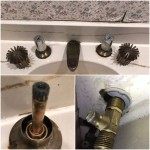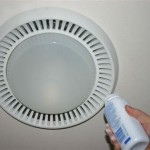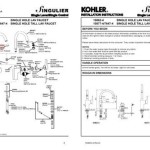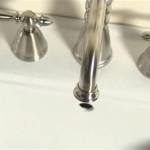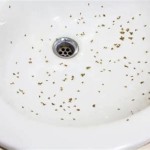How To Get Rid Of Stale Water Smell In Bathroom
A stale water smell in a bathroom is a common issue that can affect the comfort and hygiene of the space. It often indicates underlying problems such as stagnant water accumulation, improper drainage, or the presence of mold and mildew. Identifying the source of the odor is the first step towards effectively eliminating it. This article will explore the various causes of this unpleasant smell and provide detailed instructions on how to address them, ensuring a fresh and clean-smelling bathroom.
The persistence of a stale water smell is not merely an aesthetic issue. It can also be indicative of potential health concerns. Mold and mildew, which often contribute to the odor, can trigger allergies and respiratory problems in susceptible individuals. Furthermore, stagnant water can harbor bacteria and other microorganisms that can pose health risks. Therefore, addressing the root cause of the smell promptly and effectively is crucial for maintaining a healthy and comfortable living environment.
Several factors can contribute to the development of a stale water smell in a bathroom. These include infrequent use of fixtures, leading to water stagnation in pipes; leaks in plumbing systems, which create damp environments conducive to mold growth; and inadequate ventilation, which allows moisture to accumulate. Understanding these potential causes is essential for a targeted and effective approach to eliminating the odor.
The process of eliminating a stale water smell in a bathroom involves a systematic approach that includes identifying the source of the odor, cleaning affected areas, repairing any leaks or plumbing issues, improving ventilation, and taking preventative measures to avoid recurrence. Each of these steps is crucial for achieving a long-term solution and maintaining a fresh and hygienic bathroom environment.
Identifying the Source of the Stale Water Smell
The first and most crucial step in eliminating a stale water smell is to pinpoint its origin. This involves a thorough inspection of the bathroom, paying close attention to areas where water is likely to accumulate or where leaks may be present. Common sources of the smell include drains, toilets, showers, sinks, and areas under cabinets and around plumbing fixtures.
To identify the source, begin by sniffing around each potential area. Pay attention to the intensity of the smell in different locations. If the smell is strongest near a specific drain, it is likely that the drain is the source of the problem. Similarly, if the smell is more pronounced near the toilet, the toilet bowl or the area around its base may be the culprit.
Inspect the toilet for leaks around the base. Even small leaks can contribute to stagnant water accumulation and the development of odors. Check the toilet tank for any signs of condensation or water stains, which could indicate a leak inside the tank. Also, examine the supply line that connects the toilet to the water source for any signs of drips or corrosion.
Examine the shower and sink drains. Remove the drain covers and inspect the drains for hair, soap scum, and other debris. These materials can trap water and create an ideal environment for bacteria and mold growth. Use a flashlight to look further down the drain to identify any blockages or buildup that may be contributing to the smell.
Check under the sink and around plumbing fixtures for leaks. Use a dry cloth to wipe around the pipes and look for any signs of moisture. Even small drips can lead to stagnant water accumulation and the development of odors. Pay particular attention to areas where pipes connect, as these are common locations for leaks to occur.
Inspect areas under cabinets and in corners of the bathroom for signs of water damage or mold growth. Look for discoloration, staining, or peeling paint, which can indicate the presence of moisture. If you suspect mold growth, carefully examine the area for visible signs of mold, which may appear as dark spots or patches.
If you are unable to identify the source of the smell through visual inspection, you can use a moisture meter to detect hidden moisture. A moisture meter can detect moisture behind walls or under flooring, which may indicate a hidden leak or water accumulation. This can be particularly useful in identifying sources of the smell that are not readily visible.
Cleaning and Disinfecting Affected Areas
Once the source of the stale water smell has been identified, the next step is to thoroughly clean and disinfect the affected areas. This is essential for removing the bacteria, mold, and other microorganisms that contribute to the odor. The specific cleaning methods will vary depending on the source of the smell, but the general principles remain the same.
For drains, start by removing any visible debris, such as hair, soap scum, and other materials. Use a drain snake or a bent wire hanger to reach down into the drain and remove any large blockages. Once the drain is clear of debris, flush it with hot water to help dislodge any remaining buildup.
To disinfect the drain, pour a cup of baking soda down the drain, followed by a cup of white vinegar. Let the mixture fizz for about 30 minutes, then flush the drain with hot water. The baking soda and vinegar will help to neutralize odors and kill bacteria. For stubborn odors, repeat this process several times.
For toilets, thoroughly clean the bowl with a toilet bowl cleaner. Pay particular attention to the area under the rim, where bacteria and mold can accumulate. Use a toilet brush to scrub the bowl and remove any stains or buildup. Flush the toilet several times to rinse away the cleaner.
To clean the area around the base of the toilet, use a disinfectant cleaner and a damp cloth. Wipe down the floor around the toilet, paying particular attention to any areas where water may have accumulated. If you suspect a leak, remove any caulk around the base of the toilet and clean the area thoroughly before re-caulking.
For showers and sinks, clean the surfaces with a disinfectant cleaner and a scrub brush. Pay particular attention to grout lines, where mold and mildew can easily grow. Use a grout brush to scrub the grout lines and remove any stains or discoloration. Rinse the surfaces thoroughly with water.
If you find mold or mildew, use a mold and mildew remover to kill the mold and prevent it from returning. Follow the instructions on the product label carefully, and wear gloves and a mask to protect yourself from exposure to mold spores. Ventilate the area well while you are cleaning to help reduce the risk of respiratory irritation.
For areas under cabinets and in corners of the bathroom, clean the surfaces with a disinfectant cleaner and a damp cloth. If you find water damage or mold growth, remove the affected materials, such as drywall or flooring, and replace them with new materials. Be sure to address the source of the moisture problem before replacing the materials to prevent recurrence.
Repairing Leaks and Improving Ventilation
In addition to cleaning and disinfecting affected areas, it is essential to repair any leaks and improve ventilation to prevent the recurrence of the stale water smell. Leaks can provide a constant source of moisture, which can lead to stagnant water accumulation and the growth of mold and mildew. Inadequate ventilation allows moisture to accumulate, creating an ideal environment for these problems.
To repair leaks, start by identifying the source of the leak. This may involve tightening loose connections, replacing worn-out washers or O-rings, or repairing damaged pipes. If you are not comfortable making these repairs yourself, it is best to call a qualified plumber to handle the work.
Check all plumbing connections for leaks, including those under the sink, behind the toilet, and in the shower. Tighten any loose connections with a wrench. If a connection is still leaking after being tightened, replace the washer or O-ring. If the pipe itself is damaged, it may need to be replaced.
For toilet leaks, check the flapper valve and the fill valve. The flapper valve is the rubber seal at the bottom of the tank that controls the flow of water into the bowl. If the flapper valve is worn or damaged, it can leak water into the bowl, leading to a constant flow of water and a build-up of mineral deposits. Replace the flapper valve if it is worn or damaged.
The fill valve is the mechanism that controls the flow of water into the tank. If the fill valve is not working properly, it can overfill the tank, leading to water leaking out of the overflow tube. Adjust the fill valve to prevent overfilling, or replace it if it is damaged.
To improve ventilation, ensure that the bathroom has an adequate exhaust fan. The exhaust fan should be sized appropriately for the size of the bathroom and should be used whenever the shower or bath is in use. This will help to remove moisture from the air and prevent it from accumulating.
If the bathroom does not have an exhaust fan, consider installing one. An exhaust fan can be installed in the ceiling or wall and vented to the outside. If you are not comfortable installing an exhaust fan yourself, it is best to call a qualified electrician.
In addition to an exhaust fan, opening a window can also help to improve ventilation. Open a window after showering or bathing to allow fresh air to circulate and remove moisture from the air. If the weather is humid, consider using a dehumidifier to remove excess moisture from the air.
By repairing leaks and improving ventilation, it is possible to prevent the recurrence of the stale water smell and maintain a fresh and hygienic bathroom environment. Regularly inspect plumbing fixtures for leaks and use the exhaust fan or open a window after showering or bathing to prevent moisture accumulation.

Moldy Smelling Water From Bathroom Faucet Hometalk

How To Get Rid Of The Smell Stagnant Water

Why Is There A Stagnant Smell In The Bathroom

How To Make Your Toilet Smell Nice 10 Easy S

How To Remove Foul Bathroom Odor Expert Plumbing Tips

3 Ways To Remove Bathroom Odors Wikihow Life

Musty Smells In The Bathroom Clever Ideas For Odor Removal

How To Get Rid Of The Smell Stagnant Water

Your Household Water Quality Odors In Uga Cooperative Extension

10 Ways To Get Rid Of Musty Smells In Your Bathroom Mca
Related Posts
